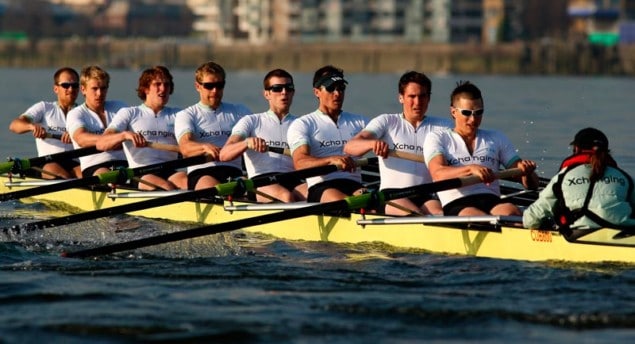
Every year, teams of rowers from Oxford and Cambridge universities sweep along the Thames river at close to 15 miles per hour in one of the world’s most famous boat races. In each boat, the oars lie alternately left and right to generate – one might assume – an even push. But is this the most effective rig?
Possibly not, according to John Barrow, a theoretical physicist at Cambridge. While not a rower himself, Barrow has produced a formula that shows which rigs will naturally travel in a straight line, without a finite mechanical moment that causes them to wiggle left and right. For an eight-oared boat there are several possible zero-moment rigs – and the traditional Oxbridge “eight” isn’t one of them.
“If you tinker with the way you seat the oarsmen it is possible to have a zero moment,” he explains. “For a four there’s only one way to do it, but for the eight, I discovered, there’s four ways to do it…Then I could show that this was equivalent to an interesting little combinatorial problem.”
Starboard to port
Barrow approached the problem by considering the simplified mechanics of rowing. The action of each oarsman, he assumed, generates a force in the rowlock that can be split into two perpendicular components: one in the backwards (bow to stern) direction, and the other in the sideways (starboard to port) direction. He calculated the individual moments by multiplying each of these sideways forces with their distance from the stern, and then added all the products to give the total moment.
As it turns out, this summation has a neat general formula, where the individual moments get incrementally bigger with distance from the stern and have opposite signs for starboard and port. So, for example, a traditional Four, which is arranged alternately, would give a total moment of 1 – 2 + 3 – 4 = –2. To get a zero moment and avoid wiggling, the rig would instead need the second and third rowers on the same side – or, in Barrow’s formula, 1 – 2 – 3 + 4 = 0.
In fact, the formula shows that, so long as the total number of oarsmen is divisible by four, any rowing boat be arranged to have a zero moment. It means there are 29 non-wiggling twelves, 263 sixteens and 2724 twenties. The eights have a mere four, of which just two – so-called “Italian” and “German” rigs – have ever been put into common practice (see figure).
Switching around oarsmen
Nick Caplan, a biomechanist at Northumbria University, thinks Barrow has tackled an “interesting and relevant” topic in rowing mechanics. However, he says that coaches and biomechanists will attempt to balance boats themselves by switching around oarsmen, who tend to exhibit subtle differences in their “force-time profile” or the way they sweep the oar. “The paper assumes that the force-time profile is the same on all oars,” he adds. “[But] if coaches could use the information presented in the paper in conjunction with knowledge of the shape of the force–time profile for each member of the crew, then it may be possible to improve boat balance and thus improve performance.”
It’s certainly not enough to turn an average crew into a winning crew Anu Dudhia, Oxford University
Anu Dudhia, a rower and physicist from Oxford University, thinks Barrow’s conclusions might not work in practice. He points out that three of the zero-moment eights have the front and back rowers on the same side, which would mean the back rower has to put his oar into the “dirty” water left from the front. He also says the effect of the wobble is usually small: “It’s certainly not enough to turn an average crew into a winning crew, as [Barrow] rather implies. While some top-level eights adopt unconventional rigs, it’s not for this reason.”
Barrow admits that his study is idealized. Still, he thinks it would be straightforward to create a model that would test the different rigs, and is keen to see if his formula can be modified for the analysis of other systems, such as insects with many legs.
The research is under review at the American Journal of Physics, and is available online on arXiv.




